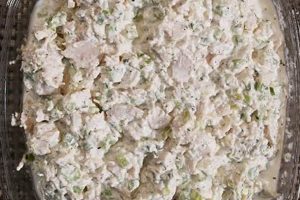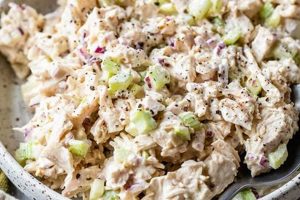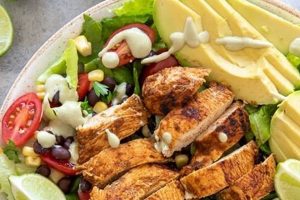A dish combining cooked chicken, typically shredded or diced, with mayonnaise, seasonings, and diced avocado creates a creamy, flavorful salad. Variations may include other ingredients such as celery, onion, grapes, nuts, or spices. A simple version might involve combining cooked chicken with mayonnaise, diced avocado, salt, and pepper. More complex recipes could incorporate a wider array of ingredients and dressings.
This combination offers a nutritious and satisfying meal or snack. Avocado adds healthy fats, fiber, and vitamins, complementing the protein provided by the chicken. The versatility of this dish allows for customization based on dietary needs and preferences. It can be served as a sandwich filling, in lettuce wraps, on crackers, or as a stand-alone salad. While the precise origin is difficult to pinpoint, the popularity of both chicken salad and avocado as individual ingredients suggests this combination emerged as a natural culinary progression, reflecting evolving tastes and preferences for healthier, flavorful options.
Further exploration will cover various preparation methods, ingredient variations, serving suggestions, and nutritional information relating to this versatile dish. From classic preparations to innovative twists, the possibilities are numerous.
Tips for Preparing an Avocado Chicken Salad
Optimizing ingredient selection and preparation techniques enhances the overall quality and flavor profile of this dish. Attention to detail ensures a satisfying culinary experience.
Tip 1: Ripe Avocado Selection: Select avocados that yield to gentle pressure but are not overly soft. Overripe avocados can result in a mushy texture, while underripe avocados lack flavor.
Tip 2: Chicken Preparation: Utilize cooked chicken, either roasted, poached, or grilled, ensuring it is cooled completely before incorporating it into the salad. Uniformly sized pieces facilitate even mixing and presentation.
Tip 3: Enhancing Flavor Profiles: Incorporating fresh herbs, such as dill, cilantro, or chives, elevates the flavor profile. Spices like paprika or cumin can add depth and complexity.
Tip 4: Balancing Texture: Adding textural elements, such as chopped celery, red onion, or toasted nuts, provides a contrasting crunch against the creamy avocado and chicken.
Tip 5: Dressing Considerations: While mayonnaise is traditional, Greek yogurt or a light vinaigrette can offer a healthier alternative. Lemon juice helps to prevent avocado browning and adds brightness.
Tip 6: Proper Storage: To prevent browning, store leftover salad in an airtight container with a layer of plastic wrap pressed directly onto the surface. Refrigeration is essential for maintaining freshness.
Tip 7: Serving Suggestions: Consider serving the salad on toasted bread, in lettuce cups, with crackers, or as a filling for wraps. Garnishing with extra avocado slices or fresh herbs enhances visual appeal.
By following these guidelines, one can achieve a well-balanced and flavorful avocado chicken salad. Careful consideration of ingredients and techniques contributes to a superior culinary outcome.
These tips provide a foundation for creating a delightful and satisfying avocado chicken salad experience. Experimentation with flavors and presentation allows for personalized variations.
1. Fresh, Ripe Avocados
Avocado selection significantly impacts the overall quality of chicken salad incorporating this ingredient. Freshness and ripeness determine the flavor, texture, and visual appeal of the final dish. Choosing optimal avocados is crucial for a successful culinary outcome.
- Flavor Contribution
Ripe avocados offer a subtly nutty, buttery flavor that complements the savory notes of chicken salad. Underripe avocados lack this characteristic flavor, while overripe avocados can develop off-flavors. This nuanced flavor profile enhances the overall complexity of the dish.
- Textural Influence
The creamy texture of a ripe avocado contributes to the desired consistency of the salad, binding ingredients and providing a smooth mouthfeel. An underripe avocado creates a firmer, less desirable texture, while an overripe avocado can become excessively mushy. Proper ripeness ensures a balanced and pleasant textural experience.
- Visual Appeal
The vibrant green hue of a perfectly ripe avocado enhances the visual presentation of the salad. Brown or discolored spots, indicative of overripeness, detract from the aesthetic appeal. A visually appealing salad contributes to a more enjoyable dining experience.
- Nutritional Value
Fresh, ripe avocados offer a wealth of nutrients, including healthy fats, fiber, and vitamins. Incorporating them into chicken salad adds nutritional value to the dish. This nutritional boost contributes to a healthier and more satisfying meal.
The careful selection of fresh, ripe avocados is essential for achieving the desired flavor, texture, appearance, and nutritional benefits in a chicken salad. This ingredient elevates the dish beyond a simple combination of ingredients, transforming it into a flavorful and healthful culinary creation.
2. Cooked chicken, diced
Cooked, diced chicken forms the foundational protein component of chicken salad with avocado. Its preparation and inclusion significantly influence the final dish’s overall quality, flavor, and texture. Employing properly cooked and diced chicken ensures a palatable and enjoyable culinary experience.
Dicing the chicken into uniform pieces promotes even distribution throughout the salad, preventing pockets of plain avocado or mayonnaise. This uniformity ensures a consistent flavor and texture in each bite. Furthermore, the cooking method employed impacts the chicken’s flavor profile. Roasting imparts a richer, more intense flavor, while poaching yields a milder, more delicate taste. Grilling introduces smoky notes, adding another layer of complexity. The choice of cooking method allows for customization based on personal preference.
Using pre-cooked rotisserie chicken offers convenience, while preparing chicken specifically for the salad allows for greater control over seasoning and flavor development. For example, marinating the chicken before grilling can infuse additional flavors. Overcooking results in dry, stringy chicken that detracts from the salad’s overall quality, while undercooked chicken presents food safety risks. Achieving the correct level of doneness is crucial. Properly cooked and diced chicken contributes significantly to the success of a chicken salad avocado recipe, influencing both taste and texture. Consideration of these factors elevates the dish from a simple combination of ingredients to a carefully crafted culinary creation.
3. Quality Mayonnaise
Mayonnaise serves as a crucial binding agent and flavor enhancer in chicken salad with avocado. Quality significantly impacts the overall sensory experience. A superior mayonnaise, typically made with real eggs and oil, contributes a rich, creamy texture and a balanced flavor profile that complements the other ingredients. Lower-quality mayonnaise, often containing modified starches and artificial flavorings, can result in a thinner, less flavorful salad, potentially overpowering the delicate taste of the avocado and chicken. For instance, a mayonnaise made with olive oil adds a subtle fruitiness, while one with expeller-pressed oils contributes a cleaner flavor profile. The choice of mayonnaise directly influences the overall taste and texture of the final product.
The emulsification properties of high-quality mayonnaise contribute to the stability of the chicken salad, preventing separation and maintaining a desirable consistency. This stability is essential for both presentation and palatability. Furthermore, the acidity level in mayonnaise plays a role in balancing the richness of the avocado and preventing browning. A mayonnaise with the correct pH level helps maintain the vibrant green color of the avocado, enhancing the visual appeal of the salad. Conversely, a mayonnaise with an imbalanced pH can lead to discoloration and a less appealing final product. Practical applications include selecting a mayonnaise specifically designed for salads or opting for a premium brand known for its quality ingredients and balanced flavor profile.
Understanding the role of mayonnaise in a chicken salad avocado recipe allows for informed ingredient selection, ultimately leading to a superior culinary outcome. Choosing a high-quality mayonnaise enhances the flavor, texture, and stability of the salad, contributing significantly to its overall appeal. The subtle nuances of different mayonnaises offer opportunities for customization and flavor exploration within this classic dish. Selecting the appropriate mayonnaise, therefore, is a key step in creating a truly satisfying and enjoyable culinary experience.
4. Complementary Seasonings
Seasonings play a critical role in elevating chicken salad with avocado beyond a simple combination of ingredients. Careful selection and application of complementary seasonings enhance the inherent flavors of the core components, creating a balanced and nuanced flavor profile. Understanding the interplay of these seasonings allows for a more sophisticated and satisfying culinary experience.
- Balancing Flavor Profiles
Seasonings provide an opportunity to balance the richness of the avocado and the savory notes of the chicken. A touch of acidity, such as lemon juice or vinegar, brightens the overall flavor, while a pinch of salt enhances the inherent sweetness of the ingredients. Black pepper adds a subtle bite, contrasting the creamy textures. The judicious use of seasonings creates a harmonious balance, preventing any single flavor from dominating.
- Enhancing Existing Flavors
Rather than masking the natural flavors of the chicken and avocado, complementary seasonings serve to amplify and enhance them. For example, a hint of garlic powder or onion powder can deepen the savory notes of the chicken, while a sprinkle of paprika or cumin adds warmth and complexity. Fresh herbs, like dill or chives, provide a bright, herbaceous counterpoint to the richness of the avocado. The strategic use of seasonings elevates the overall flavor profile without overpowering the core ingredients.
- Creating Depth and Complexity
Layering different seasonings contributes depth and complexity to the final dish. A combination of dried herbs, spices, and fresh aromatics builds a multi-dimensional flavor profile that evolves with each bite. For example, a blend of dried oregano, thyme, and a squeeze of fresh lemon juice creates a Mediterranean-inspired flavor profile. Experimenting with different combinations allows for endless customization and culinary exploration.
- Considering Dietary Restrictions and Preferences
Seasoning choices can accommodate various dietary restrictions and personal preferences. Low-sodium options cater to those watching their salt intake, while specific spice blends can create allergen-free variations. The versatility of seasonings allows for customization without compromising flavor. This adaptability makes chicken salad with avocado a suitable dish for a wide range of dietary needs and preferences.
The thoughtful application of complementary seasonings transforms chicken salad with avocado from a basic dish into a nuanced culinary creation. By carefully considering the balance of flavors, the enhancement of existing tastes, and the creation of depth and complexity, one can achieve a truly exceptional and satisfying culinary experience. This attention to detail elevates the dish, demonstrating a sophisticated understanding of flavor dynamics.
5. Optional Textural Additions
Textural additions represent a key opportunity to elevate a chicken salad avocado recipe beyond its fundamental components. Introducing contrasting textures enhances the sensory experience, creating a more dynamic and engaging interplay of elements within the dish. These additions contribute not only to the enjoyment of the salad but also to its visual appeal and overall culinary complexity.
- Nuts and Seeds
Nuts, such as toasted pecans, walnuts, or almonds, provide a satisfying crunch and nutty flavor that complements the creamy avocado and savory chicken. Seeds, like sunflower or pumpkin seeds, offer a similar textural contrast and contribute additional nutritional value. The choice of nuts or seeds can be tailored to personal preference and dietary considerations, offering a versatile avenue for customization.
- Vegetables
Finely diced celery and red onion introduce a crisp, refreshing element that contrasts with the softer textures of the avocado and chicken. Water chestnuts offer a uniquely mild flavor and a satisfying crunch. These additions not only enhance textural complexity but also introduce subtle flavor nuances and visual appeal.
- Fruits
Incorporating fruits like grapes or dried cranberries adds a touch of sweetness and a burst of contrasting flavor. The subtle sweetness complements the savory notes of the chicken and the richness of the avocado. These additions create a more dynamic flavor profile and contribute visual interest.
- Croutons or Crispy Bread Pieces
Croutons or small pieces of toasted bread provide a satisfying crunch and absorb excess moisture, maintaining the salad’s desired consistency. The added texture contrasts with the creamy avocado and tender chicken, creating a more balanced and enjoyable eating experience.
Strategic incorporation of textural additions elevates the chicken salad avocado recipe from a simple combination of ingredients to a more sophisticated and satisfying culinary experience. These additions enhance not only the textural complexity but also the flavor profile and visual appeal of the dish. Consideration of these elements allows for customization and a greater degree of culinary control, resulting in a more enjoyable and memorable meal.
6. Proper Storage Techniques
Proper storage techniques are essential for maintaining the quality, safety, and flavor of chicken salad with avocado. This highly perishable dish requires careful attention to storage practices to prevent bacterial growth and preserve its desirable characteristics. Effective storage ensures optimal food safety and maximizes the shelf life of the prepared salad.
- Temperature Control
Maintaining a consistently low temperature is paramount for inhibiting bacterial growth in chicken salad containing avocado. Refrigeration at or below 40F (4C) is crucial for preserving freshness and preventing spoilage. Fluctuations in temperature can create an environment conducive to bacterial proliferation, increasing the risk of foodborne illness. Consistent refrigeration is essential for ensuring food safety.
- Air Exposure Limitation
Limiting exposure to air minimizes oxidation, which can lead to browning of the avocado and degradation of flavor. Storing the salad in an airtight container or covering the surface directly with plastic wrap helps maintain the vibrant green color of the avocado and preserves the fresh taste of the other ingredients. This practice also helps prevent the salad from absorbing odors from other foods in the refrigerator.
- Time Sensitivity
Chicken salad with avocado has a limited shelf life, even when properly stored. Consuming the salad within 3-4 days of preparation is recommended for optimal quality and safety. Beyond this timeframe, the risk of bacterial growth increases significantly, even under refrigeration. Adhering to recommended storage times minimizes potential health risks.
- Proper Container Selection
Selecting appropriate storage containers plays a crucial role in maintaining the quality of the salad. Airtight containers made of glass or food-grade plastic are ideal. These materials prevent the absorption of odors and maintain a consistent internal environment. Avoid using reactive metals, such as aluminum, which can interact with the acidic ingredients in the salad and impart off-flavors.
Implementing these proper storage techniques safeguards the quality and safety of chicken salad with avocado, ensuring a satisfying and enjoyable culinary experience while minimizing the risk of foodborne illness. Careful attention to temperature, air exposure, storage duration, and container selection preserves the flavors and textures of the ingredients, maximizing the shelf life of this delicate dish.
7. Creative Serving Suggestions
Presentation significantly influences the perceived value and enjoyment of chicken salad with avocado. Moving beyond the conventional bowl broadens culinary horizons and elevates the dining experience. Creative serving suggestions transform this dish from a simple staple into a versatile and visually appealing culinary creation.
- Beyond the Sandwich
While chicken salad traditionally graces sandwiches, utilizing it as a filling for lettuce wraps, bell peppers, or tomatoes offers a lighter, lower-carbohydrate alternative. These options cater to various dietary preferences and add visual appeal. For example, colorful bell pepper halves filled with the salad create a vibrant and refreshing presentation. Such alternatives demonstrate versatility and expand the dish’s potential beyond its traditional role.
- Appetizer Applications
Chicken salad with avocado functions effectively as an appetizer. Served on endive spears, cucumber rounds, or crackers, it provides a flavorful and visually appealing start to a meal. Mini phyllo cups or wonton wrappers baked and filled with the salad offer a more substantial and elegant appetizer option. This application highlights the salad’s adaptability and suitability for diverse culinary contexts.
- Elevated Entres
Transforming chicken salad with avocado into an entre involves incorporating it into larger culinary creations. Topping a bed of mixed greens with the salad creates a light yet satisfying meal. Stuffed avocados present a visually striking and flavorful entre. Incorporating the salad into a crepe or omelet introduces a savory breakfast or brunch option. These applications demonstrate the salad’s potential as a core component of more complex dishes.
- Presentation and Garnishing
Visual presentation enhances the dining experience. Garnishing the salad with fresh herbs, a sprinkle of paprika, or a drizzle of olive oil adds visual appeal and elevates perceived flavor. Serving the salad in a scooped-out avocado half or arranged on a bed of lettuce adds an element of elegance. Thoughtful presentation transforms a simple salad into a visually appealing culinary creation. The impact of visual elements underscores the importance of presentation in elevating the overall dining experience.
Creative serving suggestions enhance the versatility and appeal of chicken salad with avocado, demonstrating its adaptability to various culinary contexts. Exploring these alternatives allows for a more engaging and satisfying dining experience, transforming a familiar dish into a culinary centerpiece. The potential for customization and creative expression within this seemingly simple dish is considerable, offering a platform for culinary exploration and personalized presentation.
Frequently Asked Questions
This section addresses common inquiries regarding the preparation, storage, and variations of chicken salad incorporating avocado.
Question 1: How can browning of the avocado be prevented after the salad is prepared?
Limiting exposure to air is crucial. Storing the salad in an airtight container or pressing plastic wrap directly onto the surface minimizes oxidation, a primary cause of browning. Adding a small amount of lemon or lime juice to the salad also helps prevent discoloration due to its antioxidant properties.
Question 2: What are suitable alternatives to mayonnaise in this recipe?
Greek yogurt offers a healthier alternative to mayonnaise, providing a tangy flavor and creamy texture. Mashed avocado can also serve as a substitute, enhancing the avocado flavor and contributing healthy fats. Alternatively, a light vinaigrette can create a brighter, less creamy salad variation.
Question 3: How long can chicken salad with avocado be safely stored?
Refrigeration at or below 40F (4C) is crucial. Even under proper refrigeration, consuming the salad within 3-4 days of preparation is recommended for optimal quality and safety. Beyond this period, the risk of bacterial growth increases substantially.
Question 4: Can canned chicken be used in this recipe?
While canned chicken can be used, its texture often differs from freshly cooked chicken. Draining the canned chicken thoroughly and opting for a variety packed in water rather than oil helps minimize excess moisture and unwanted flavors. Freshly cooked chicken generally yields a superior texture and flavor profile.
Question 5: What are some ways to add more flavor complexity to the salad?
Incorporating spices such as cumin, paprika, or curry powder adds depth and warmth. Fresh herbs like dill, cilantro, or chives introduce brightness. Toasted nuts or seeds provide textural contrast and nutty undertones. Experimentation with these additions enhances the overall flavor complexity.
Question 6: Can this salad be frozen for later consumption?
Freezing is not recommended. The avocado’s texture degrades significantly upon freezing and thawing, resulting in a watery and less palatable consistency. Mayonnaise-based salads also do not freeze well, as the emulsion can separate upon thawing. Preparing and consuming the salad fresh ensures optimal quality and flavor.
Understanding these key aspects of preparation, storage, and customization empowers culinary exploration and ensures a safe and satisfying dining experience. Addressing these frequently asked questions fosters a deeper understanding of the nuances of chicken salad with avocado preparation and consumption.
This concludes the frequently asked questions section. The following segment will provide a summary of key takeaways and concluding remarks regarding the preparation and enjoyment of chicken salad with avocado.
Chicken Salad Avocado Recipe
Exploration of this culinary combination reveals the interplay of essential elements contributing to a successful outcome. Ingredient selection, from ripe avocados and properly cooked chicken to quality mayonnaise and complementary seasonings, significantly impacts the final product. Textural additions introduce complexity, while proper storage techniques preserve freshness and flavor. Creative serving suggestions elevate presentation and expand culinary possibilities. Attention to these details transforms a simple combination of ingredients into a nuanced and satisfying dish.
Culinary endeavors involving chicken salad with avocado benefit from a thorough understanding of these components. Careful consideration of each element allows for informed choices, maximizing flavor, texture, and overall culinary satisfaction. This knowledge empowers informed experimentation and personalized variations, fostering continued culinary exploration and appreciation for this versatile dish.






